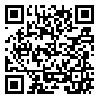Volume 12, Issue 3 (12-2019)
ijhe 2019, 12(3): 449-460 |
Back to browse issues page
1- Department of Fisheries, Faculty of Marine Science and Technology, University of Hormozgan, Hormozgan, Iran
2- Department of Fisheries, Faculty of Marine Science and Technology, University of Hormozgan, Hormozgan, Iran ,Abolfazlnaji@gmail.com
2- Department of Fisheries, Faculty of Marine Science and Technology, University of Hormozgan, Hormozgan, Iran ,
Abstract: (4054 Views)
Background and Objective: Microplastics (MPs) are well-known emerging contaminants in the marine environment. A key route by which MPs can directly affect marine life is through ingestion.
Materials and Methods: In order to investigate and measure MPs in the Persian Gulf, random sampling and digestion of tissues and flotation of MPs were used. This method has been used to study the frequency, distribution, shape and color of MPs in in the digestive system of fish in the Persian Gulf.
Results: According to the results, the highest concentration of extracted MPs were found in Sillago sihama (62%), Diagramma pictum (26%), Lutjanus johnii (6%), Otolithes ruber (5%), Epinephelus coioides (1%). However, MPs were not observed in Scomberomorus commerson.
Conclusion: The relative contribution of different forms of MPs in any fish showed that microfibers with the most abundant forms of MPs and fragments and films were observed to have the lowest concentration of 11% and 2%, respectively. Based on our results, it is suggested that Sillago sihama is suitable indicator of MPs contamination among studied fish in the Persian Gulf. Ingestion of MPs provides a potential pathway for the transfer of plastic additives, metals, PAHs and other POPs to wildlife and human consumers of fish. Therefore, more comprehensive investigations on MPs and nano-plstics should be conducted in food chain of seafood.
Materials and Methods: In order to investigate and measure MPs in the Persian Gulf, random sampling and digestion of tissues and flotation of MPs were used. This method has been used to study the frequency, distribution, shape and color of MPs in in the digestive system of fish in the Persian Gulf.
Results: According to the results, the highest concentration of extracted MPs were found in Sillago sihama (62%), Diagramma pictum (26%), Lutjanus johnii (6%), Otolithes ruber (5%), Epinephelus coioides (1%). However, MPs were not observed in Scomberomorus commerson.
Conclusion: The relative contribution of different forms of MPs in any fish showed that microfibers with the most abundant forms of MPs and fragments and films were observed to have the lowest concentration of 11% and 2%, respectively. Based on our results, it is suggested that Sillago sihama is suitable indicator of MPs contamination among studied fish in the Persian Gulf. Ingestion of MPs provides a potential pathway for the transfer of plastic additives, metals, PAHs and other POPs to wildlife and human consumers of fish. Therefore, more comprehensive investigations on MPs and nano-plstics should be conducted in food chain of seafood.
Type of Study: Research |
Subject:
General
Received: 2019/05/7 | Accepted: 2019/07/9 | Published: 2019/12/21
Received: 2019/05/7 | Accepted: 2019/07/9 | Published: 2019/12/21
| Rights and Permissions | |
 |
This work is licensed under a Creative Commons Attribution-NonCommercial 4.0 International License. |


